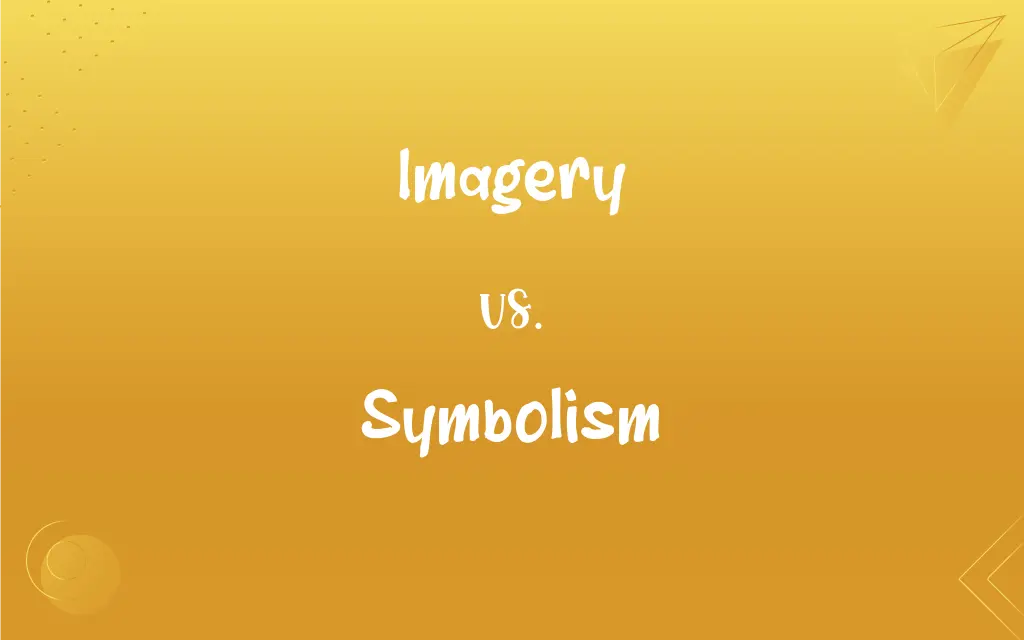Imagery vs. Symbolism: What's the Difference?
Edited by Aimie Carlson || By Harlon Moss || Updated on November 25, 2023
Imagery involves descriptive language that evokes sensory experiences, while symbolism uses objects, characters, or actions to represent abstract ideas.

Key Differences
Imagery, in literature and art, pertains to the use of vivid and descriptive language that paints a picture in the reader's or viewer's mind. It predominantly targets the five senses, allowing one to "see" a sunset, "hear" a bird, or "feel" a breeze. Symbolism, on the other hand, goes beyond the literal to convey deeper, often abstract, meanings. When an author uses an object, character, or action as a symbol, they are intending for it to represent something more than its obvious and immediate meaning.
In its core, imagery aims to evoke sensory reactions and create vivid mental images. An author might use detailed descriptions to make a scene more lifelike or to immerse the reader in the story's atmosphere. Symbolism, contrastingly, is more about conveying thematic elements of a story. A symbol stands for something beyond itself, often allowing writers to convey complex ideas without lengthy explanations.
Imagery enriches a narrative by adding depth and color to descriptions. It brings scenes to life and makes characters more relatable by appealing directly to the reader's senses. Symbolism, while more subtle, provides layers of meaning to a story. A simple object or action, when symbolic, can encapsulate an entire theme, belief, or concept, making the narrative more multifaceted and profound.
To illustrate, consider the description of a dilapidated house with shattered windows, creaky doors, and a crumbling roof. Through imagery, a reader can visualize this setting and perhaps feel the eeriness of it. If this house, however, is used to symbolize a person's deteriorating mental state, then it serves as symbolism, adding depth and meaning to the narrative.
Comparison Chart
Definition
Descriptive language targeting senses.
Objects or actions representing abstract ideas.
ADVERTISEMENT
Primary Purpose
Evoke sensory reactions.
Convey deeper meanings.
Nature
Literal and sensory-focused.
Abstract and thematic-focused.
Function in Literature
Paints a vivid picture.
Adds layers of meaning.
Usage
Direct descriptions.
Objects, actions, or characters with dual meanings.
Imagery and Symbolism Definitions
Imagery
Language that evokes sensory experiences.
The imagery of the sizzling pan made me feel the heat.
ADVERTISEMENT
Symbolism
The use of symbols to represent ideas or concepts.
The river's flow was a clear symbolism for life's journey.
Imagery
Descriptive language that appeals to the senses.
The imagery of the rustling leaves brought the forest to life.
Symbolism
An artistic representation of abstract themes.
The novel's repeated bird imagery was a potent symbolism of freedom.
Imagery
Words or phrases making abstract ideas tangible.
Her speech's imagery gave shape to our shared dreams.
Symbolism
Objects or actions carrying deeper meanings than their literal sense.
The shattered vase was a striking symbolism of their broken relationship.
Imagery
Vivid descriptions creating mental pictures.
Through his imagery, the bustling city seemed almost touchable.
Symbolism
Infusing elements with secondary, abstract interpretations.
The stormy sea was more than nature's fury; it was a symbolism of internal chaos.
Imagery
Expressions that conjure visual scenes.
The poet's imagery transported me to serene lakesides.
Symbolism
Characters or events standing for broader concepts.
The wall in the story was a stark symbolism of societal divides.
Imagery
A set of mental pictures or images.
Symbolism
The practice of representing things by means of symbols or of attributing symbolic meanings or significance to objects, events, or relationships.
Imagery
The use of vivid or figurative language to represent objects, actions, or ideas.
Symbolism
A system of symbols or representations.
FAQs
How does symbolism function in literature?
Symbolism uses objects or actions to represent deeper, often abstract, meanings.
Can a piece of writing use both imagery and symbolism?
Yes, many literary works employ both for vivid descriptions and layered meanings.
Is imagery only visual?
No, it can appeal to all five senses: sight, sound, touch, taste, and smell.
Is all descriptive language considered imagery?
Mostly, especially if it evokes clear sensory experiences for the reader.
Does imagery always need detailed descriptions?
Not always, but specific details enhance the sensory experience.
Are symbols universally understood?
Some, like the heart symbolizing love, are widely recognized, but context can change interpretations.
How is imagery different from symbolism?
While imagery creates sensory-rich visuals, symbolism imparts deeper thematic interpretations.
Why do authors use imagery?
To immerse readers in the setting, mood, or emotion of the story.
What is imagery?
Imagery involves descriptive language that paints a vivid picture by appealing to the senses.
What makes symbolism powerful?
Its ability to convey profound ideas without direct statements.
How can readers identify symbolism?
Look for recurring objects or actions with potential deeper meanings.
Can symbolism be cultural?
Yes, symbols often vary in meaning across different cultures.
Can characters in a story be symbols?
Absolutely, characters can symbolize concepts like hope, decay, or rebellion.
How does imagery enhance poetry?
It makes abstract feelings tangible, allowing readers to "experience" emotions.
How can one improve using imagery in writing?
By observing the world keenly and translating sensory experiences into descriptive language.
Why might an author use symbolism over direct statements?
To allow readers to infer meaning, making engagement deeper and more interpretative.
Can a single object be both imagery and a symbol?
Yes, like a red rose described vividly (imagery) and symbolizing love.
Is metaphor a form of imagery?
Yes, metaphors can be considered imagery if they evoke sensory experiences.
Does symbolism need to be deep or complex?
No, even simple objects can carry symbolic weight depending on the context.
What's an example of auditory imagery?
The whispering winds or the echoing footsteps.
About Author
Written by
Harlon MossHarlon is a seasoned quality moderator and accomplished content writer for Difference Wiki. An alumnus of the prestigious University of California, he earned his degree in Computer Science. Leveraging his academic background, Harlon brings a meticulous and informed perspective to his work, ensuring content accuracy and excellence.
Edited by
Aimie CarlsonAimie Carlson, holding a master's degree in English literature, is a fervent English language enthusiast. She lends her writing talents to Difference Wiki, a prominent website that specializes in comparisons, offering readers insightful analyses that both captivate and inform.






































































